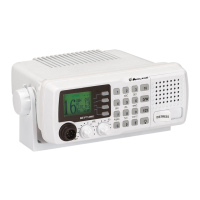
Do you have a question about the Midland neptune and is the answer not in the manual?
| Frequency range | 156.025-163.275 MHz |
|---|---|
| Channels | All USA, International and Canadian marine channels |
| Display | LCD |
| Bluetooth | No |
| Type | Handheld VHF Marine Transceiver |
| Waterproof Rating | IPX7 |
Explanation of symbols used to highlight urgent situations, practical advice, and general information.
Covers general safety, radiofrequency/installation, ATIS, and environmental warnings for the transceiver.
Details on ETSI requirements for marine transceivers with DSC function class 'D'.
Information on GMDSS/DSC functions, operator certificates, MMSI numbers, and ATIS.
Guidance on finding the serial number for assistance and notes regarding manual accuracy.
Overview of the NEPTUNE transceiver's features, including performance and capabilities.
Detailed description of buttons, knobs, and the keypad on the front panel of the NEPTUNE transceiver.
Information on the sockets and connectors located on the back panel of the transceiver.
Explanation of buttons on the microphone for channel selection and transmission.
List of items included in the NEPTUNE transceiver package.
Guidelines for selecting an optimal location for installing the transceiver.
Step-by-step instructions for mounting the NEPTUNE transceiver using the provided bracket.
Procedure for adjusting the tilt angle of the transceiver after installation.
Recommendations for optimal antenna installation and minimizing RF exposure.
Guidance on where and how to mount the microphone.
Diagram and explanation of all necessary connections for the transceiver.
Details on connecting the power supply, including voltage and fuse information.
Information on connecting a GPS receiver for position and time data.
Advice on connecting the antenna and ensuring its proper working order.
How to power the NEPTUNE transceiver on and off using the OFF/VOLUME knob.
Adjusting the audio volume level for received communications.
Setting the squelch level to eliminate background noise.
Methods for selecting channels using the keypad or microphone buttons.
Procedure for transmitting and receiving communications using the PTT button.
Switching between high (25W) and low (1W) transmission power.
Quick access to emergency channel 16 using the dedicated button.
How to adjust the LCD display's backlight for better visibility.
Automatic search for signals across marine channels, pausing on detection.
Features for monitoring channel 16 and an additional user-selected channel.
Procedure for enabling and managing Dual Watch and Triple Watch functions.
Using memory channels for scanning and storing favorite channels.
How the transceiver displays vessel position and time data when connected to a GPS.
Illustration of how position and time data appear on the NEPTUNE's display.
Overview of DSC as a semi-automatic calling method for maritime security.
Importance of programming the MMSI code for DSC communication.
How to access and navigate the various DSC functions and settings.
Procedure for making an individual DSC call to a specific vessel or station.
How to initiate a group DSC call to multiple stations with the same MMSI group code.
Sending safety or urgency calls to all vessels, including 'All Ship Safety' and 'All Ship Urgency'.
Procedure for sending a DSC distress call, including selecting the nature of distress.
How the transceiver handles incoming distress calls, including alarms and display information.
Procedure for handling 'General Call to All Ships' and 'All Ship Urgency' calls.
How the transceiver responds to and displays incoming individual DSC calls.
Introduction to personalizing the transceiver and necessary data input.
How to access and navigate the settings menu using function keys.
Summary of customizable settings, including Log, Dir, Posn, LCD, Beep, ZONE, MMSI, and ATIS.
Consulting the directory of latest registered DSC calls.
Managing MMSI owner names and codes in the directory.
Setting position coordinates and adjusting UTC time manually or via GPS.
Adjusting the display contrast for optimal visibility under different ambient conditions.
Enabling or disabling the audible beep for key presses.
Adjusting time deviation from UTC to display local time.
Entering personal MMSI code and MMSI group code.
Setting ATIS code and activating automatic transmission for inland waterways.
Guidance on maintaining the transceiver and important warnings for its upkeep.
Technical details of the transmitter, including output power and modulation type.
Technical details of the receiver, including sensitivity and audio output.
